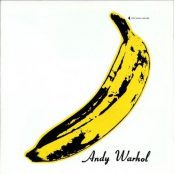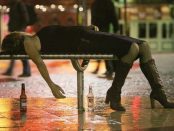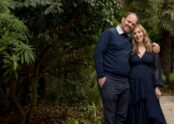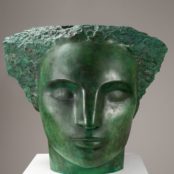Anyone living in London will have noticed that in preparation for the Olympic Games, a myriad of shiny new buildings, facades and artworks are materializing all over our City.
This weekend I decided to bypass the luster and ostentation of new sights, and the glister of resurfaced old ones. I took a closer look at the things that have de-materialised, or are simply not there. (Like the Australian team bus that got lost somewhere between Heathrow and the Olympic Park last week, being spotted briefly somewhere around Buckingham Palace).
As I wandered along London’s Southbank, the first clear (so to speak) example was the invisible bridge at Blackfriars, with its solid red Victorian pilings jutting from the Thames, alongside the ongoing renovation of (real) Blackfriars Bridge. Designed by Joseph Cubitt in 1864, this original Blackfriars Bridge was too weak to support our modern trains, and so it was dismantled, leaving behind the ghost of a bridge – easy to draw in with your imagination atop the red pillars, it’s one of my favourite quirks of the river.
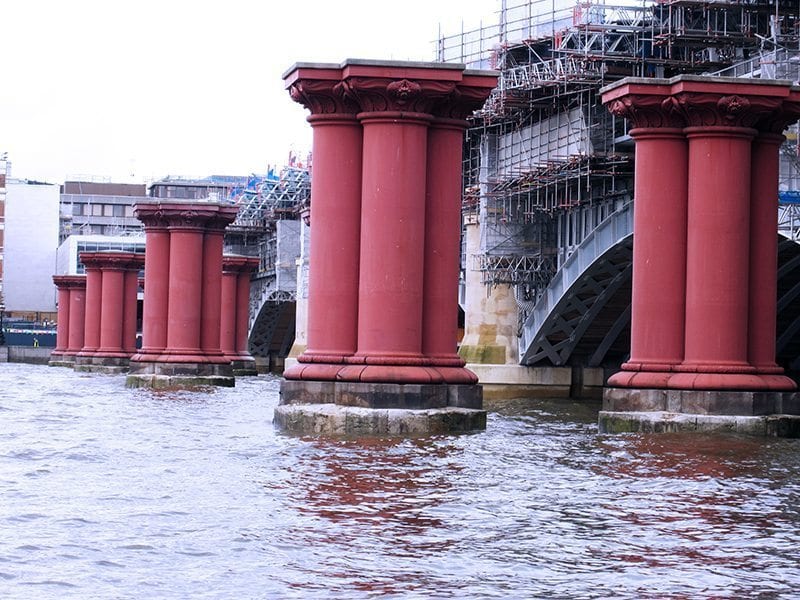
Invisible bride at Blackfriars – Old blackfriars Bridge by Joseph Cubitt
Next stop, I popped for lunch at the National Gallery, staring longingly at the pathway to its secret room (‘Room A’) which visitors are not allowed into, imagining all sorts of canvases and wonders behind it’s closed doors which are rumored to enclose over 800 artworks. My mind boggled. However, I soon consoled myself with an extremely tasty Chelsea Bun from the National Gallery Cafe. (Actually I picked up the wrong one and it turned out to be filled with surprise Belgian chocolate and hazelnuts – a most delicious miscalculation.)
Moving on I meandered back along the river towards the Hayward Gallery. Outside you will find much going on, with the cultural explosion that accompanies the Olympics (pictured below).
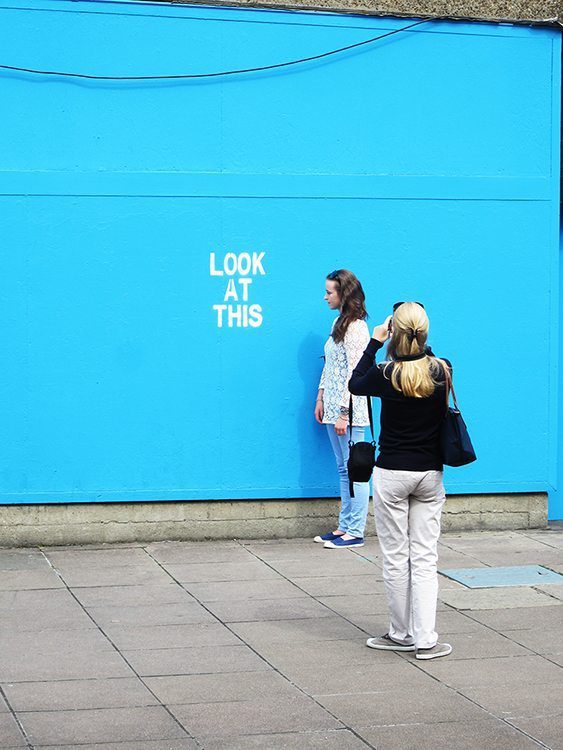
Invisible art outside Hayward Gallery southbank
But of course, my final destination was the Invisible exhibition at the Hayward. Showcasing ‘art about the unseen’ from 1957 – 2012, it is the first UK survey exhibition of artworks to explore ideas related to the invisible, the hidden and the unknown. You can experience an invisible labyrinth and canvases primed with invisible ink, pieces that use mental energy and snow water as their medium, and an empty plinth that presents space cursed by a witch. The controversial exhibition features works by some of the most important artists from the past half century including Andy Warhol, Yves Klein, Robert Barry, Chris Burden, Yoko Ono, Maurizio Cattelan and Carsten Höller.
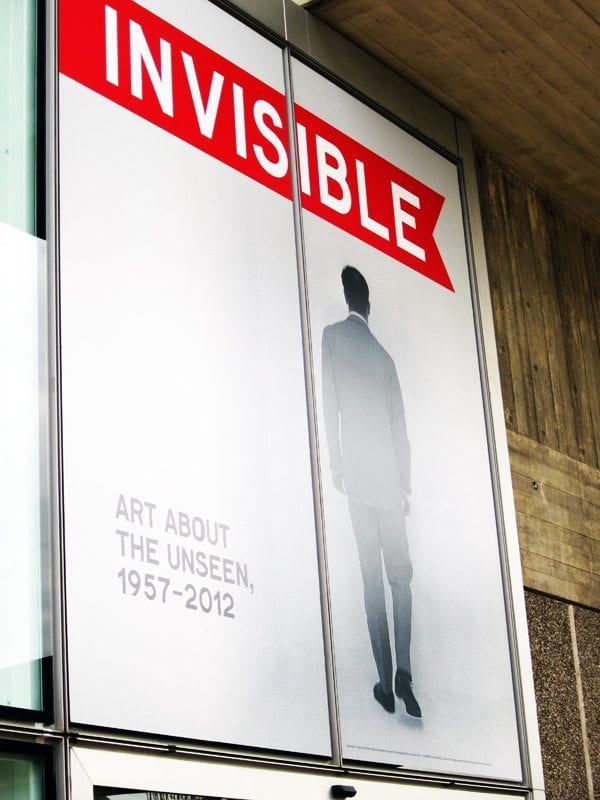
It is a show about conceptual content rather than visual content, so if you are all about the visual impact, composition or colour, it’s probably not your cup of tea. However, if you can get your mind around the idea that art is not necessarily a visual medium, and that the concept behind the artwork is where a significant part of any good artist’s merits lie, then this is worth challenging yourself with.
mocking both the viewer and the idea of conceptual artwork itself
I traversed the show with a smile on my lips, occasionally chuckling to myself at art which was largely quite playful, mocking both the viewer and the idea of conceptual artwork itself. Maurizio Cattelan presents a police report of a ‘stolen invisible artwork’, conjuring images of detectives running about with magnifying glasses, looking for a painting which lurks, unseen, right beneath their noses.
My own approach to the often abstruse world of conceptual art, is that we have to stop thinking of art as we do a novel, which tells a story and ‘paints a picture’ for us, the job of an artwork is not to be immediately obvious or even visual. We know that artwork can exist to focus purely on its physical or emotional impact on us. There are many examples of sensory sound pieces such as Witness, by Susan Hiller, (involving speakers suspended at ear height, whispering hundreds of separate tales), or Turner Prize winning sound installation artist Susan Philipsz. We know also that art can even be purely olfactory, as in the case of Ernesto Neto and his hanging spice-filled globular forms, whose pungent materials become a scent sculpture in their own right, invisibly snaking around the gallery.
We could think of artworks more like poetry. A poem can abstractly string together concepts, allusions, words, feelings, moments. It does not have to be complete, self explanatory or immediately obvious. As readers we take pleasure in trying to interpret the meaning, link the different references to uncover the message, or using the loose elements as starting points from which our brains can wander along their own tangents.
It is with this attitude that you can start to explore and appreciate shows like Invisible. Once you open your mind up, it becomes all about the ideas of the artwork and in some cases the thoughts and images that this conjures in your own imagination. It is the difference between the passive act of ‘seeing’, where you just sit back and absorb the visuals, and actually ‘reading’ the artworks, so that your own imagination get’s sucked in and builds on the story itself. But with this selection of work being nearly completely devoid of visual content, the skeptic in us all still asks – is it just a case of ‘the emperor’s new clothes’? Trying to understand and decode these artworks could certainly echo that earlier image of police detectives. Are we taking things too seriously and becoming the butt of the joke?
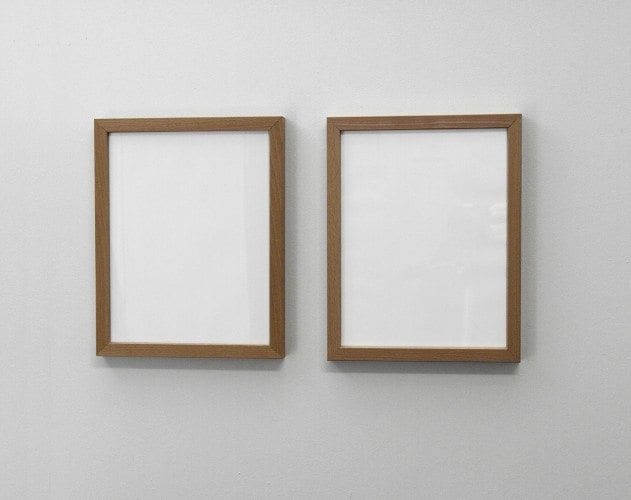
Gianni Motti – Magic Ink. Courtesy Hayward Gallery.
However, this exhibition did contain quite a few interesting pieces, and most had a kernel of cleverness. As there is less to actually see, you can get round the exhibition pretty quickly without the need to lean in and admire the brushwork, examine the textures, or gaze at the colours and forms like you would in other shows. But there were a few exceptions in which the lack of visuals actually extended the experience of the piece – perhaps because, for me, my other non-visual senses take a lot longer to process artwork.
Some of the most absorbing were Yoko Ono’s Instruction Paintings, in which she tells you how to make the artwork she envisages. In the process of reading the instructions, a very vivid image of the painting arises in your mind. The beauty of this, conveyed simply through a few lines of words, was very moving and powerful. The paintings do actually exist, in our minds. Is this any less real than us reading about it in a book or seeing pictures of it online?
Perhaps it is more real in a profound way – so many people have experienced these imagined paintings in their minds, yet the physical thing does not exist. For me this makes a beautiful connection between all those who have read one of the Instruction Paintings, in a deeper way than a moving moment in front of a physical canvas would. It feels somehow more special: We, the viewer, are a part of the creation of this work, which would not exist without being read. One of her poetic instruction paintings is below (source A-I-U website):
PAINTING TO LET THE EVENING LIGHT GO THROUGH (1961)
Hang a bottle behind a canvas. Place the canvas where the west light comes in. The painting will exist when the bottle creates a shadow on the canvas, or it does not have to exist. The bottle may contain liquor, water, grasshoppers, ants, or singing insects, or it does not have to contain.
Finally, here are three pieces which had quite a physical effect on me, described below (if you want to find out for yourself stop reading here and visit before 5th August).
Once I had explored the first couple of rooms, I thought I had viewed the whole exhibition, but I knew there were some other pieces I expected to see. So I ventured back into the second room, the walls dotted with with framed white paper, a suspended blank canvas and a sheet of fully exposed photographic paper showing the image of ‘whiteness’. I noticed that tucked behind the far wall, nearly invisible itself, was a further installation, the entrance covered with heavy black curtains. Stepping through them ensconced me in their darkness.
Beneath my feet I could feel the floor was soft, as if carpeted. All around me was the thickness of absolute darkness, it felt loaded. Unable to see or sense anything, I decided to just stand still for a while to experience this absence of light, and then retreat – until I realised that the rest of the show lay in wait on the other side of the dark void.
Slowly, I became aware of the sounds of other people. Slightly embarrassed, I realised I was probably not alone in this space, I could have been standing face to face with a stranger. Tentatively, I shuffled forwards and blindly held out my hands. I heard the rustling of exhibition guides and faint footsteps. After what seemed a while, I became aware of a faint vertical sliver of light – the curtained exit on the opposite wall. This subtle direction was so imperceptible I could not really judge the distance, but began shuffling gingerly towards it, aware of the sensation of the floor against my soles and the dense blackness inches from my face.
I reached the other side and emerged blinking into a gallery space, where no one took any notice of me even though I felt like I had overcome some kind of hurdle. This piece, by performance artist James Lee Byars entitled The Ghost of James Lee Byars (1969/1986), is designed to evoke the artist‟s spiritual afterlife. I’m wouldn’t say that is what I was experiencing, but it was a powerful example of how the nothingness of taking away the visible can have a significant effect, in similar style to Miroslaw Balka’s immense steel container. For me the macabre ghost story was superfluous to the piece.
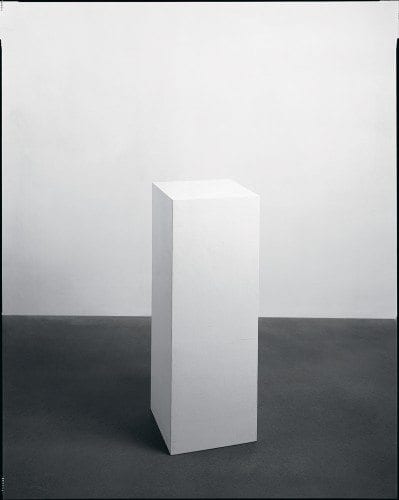
Tom Friedman – Untitled (A Curse). Courtesy Hayward Gallery.
I stepped into the large tiled gallery space. Nothing seemed present but a solitary plinth on the far side, and, when I looked down, some road-markings which I was in fact standing on. (Carsten Holler’s “The Invisible” racecar). I looked round for some direction – to this point all the exhibition signage had been engraved onto clear perspex or written in light text grey on very light grey wall labels (an added bit of fun from the curators).
Eventually I saw a fellow visitor gazing at the wall, and sure enough she was reading a sign, differing from the rest with a graphite outline. To make it more visible from afar? I thought. I read: “You are now standing inside possibly the largest line drawing in the world.” Hurrah – something exciting was coming! As I read on and then discovered for myself – by closely examining the floor and standing with my face pressed into the four corners of the room – the artist Lai Chih-Sheng has created a giant “invisible drawing”. Using a pencil to draw over all of the existing lines formed by the gallery’s interior architecture, he has subtly marked each corner, fold, crease or join of the room. In itself it was a nice feeling to be standing within the space of a drawing. It also immediately brought into mind the sight of the artist lying on the floor as he drew round each tile, clambering up ladders as his pencil outlined signs and ceilings. Additionally it was fun to re-explore, to see things in this space that you probably never noticed before.

LAI Chih-Sheng installing his work Life-Size Drawing as part of “Invisible: Art about the Unseen 1957-2012” at the Hayward Gallery, London. Courtesy the artist and Hayward Gallery, Southbank Centre
My final favourite, came in the form of the Invisible Labyrinth by Jeppe Heine. The maze is made of a seemingly invisible ‘force-field’, that vibrates as you bump into it (via your digital headphones, handed out at the start.) What was most interesting about this was not just navigating the virtual walls, but watching the other participants – particularly before I really knew what it was all about – seeing them moving around clearly not paying attention to each other or the room around them, but tracing along an unseen path, shuffling hesitantly in what they thought was the right direction, then abruptly stopping and changing direction like some strange disjointed dance. The structure spans seven different variants, changing from day to day.
Over all I came away having enjoyed the show, admittedly more interesting to me than the completely absent art were the pieces that were invisible but engaged other senses or ways of seeing. I don’t think I (or the curators) are advocating that all art should be invisible or that the visible is not valuable and stimulating, but this show certainly challenged some of the lesser used grey cells to become rather more lucid.

Jeppe Hein – Invisible Labyrinth. Courtesy Hayward Gallery.
Nicola Anthony is an artist and art writer living & working in London. She seeks to discover things which make her mind crackle with creative thought. Catch @Nicola_Anthony on twitter, or her artist’swebsite
Nicola Anthony is a British artist known for her public art around the world. Her text sculptures are made of metal, words, memories and narratives. She has worked internationally with NGOs, art institutions, public spaces and cultural research bodies to create art which tells the stories that are often left unspoken.



